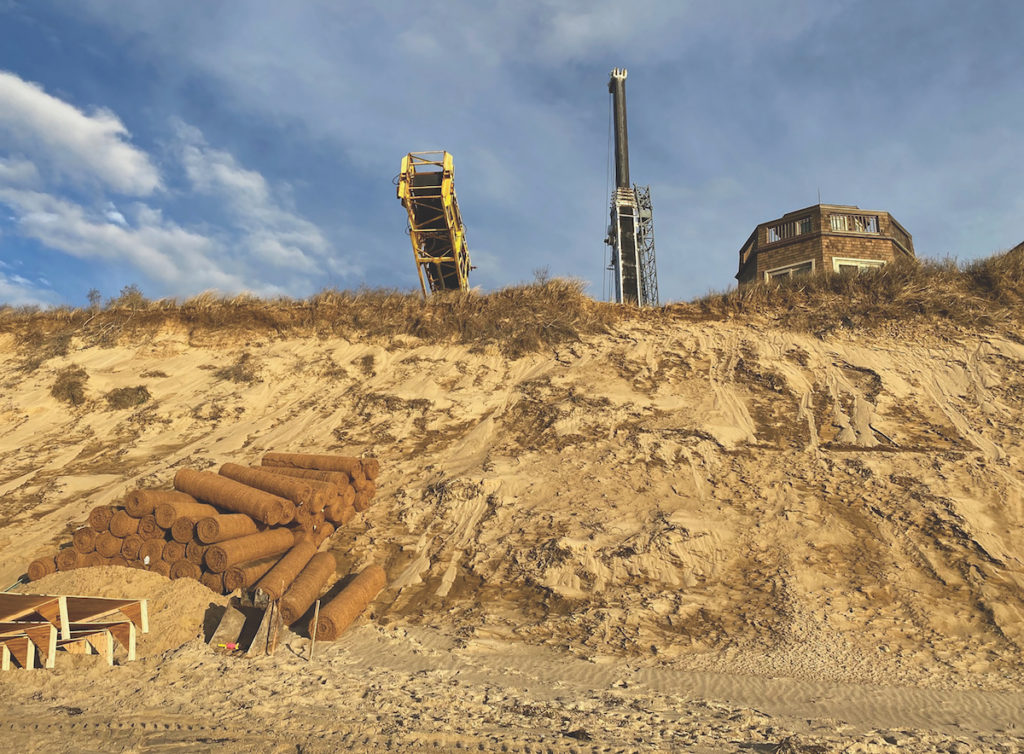
WELLFLEET — The long-running drama of the Blasch house continues, as the structure is now just 12 to 14 feet from the edge of the coastal bank high above Cape Cod Bay. Its owners received emergency certification on Dec. 2 to use sandbags to slow erosion of the bank while they wait for the Barnstable Superior Court — or Mother Nature — to act.
Mark and Barbara Blasch have been trying for over a year to get permission to erect a 240-foot stone seawall to keep their 5,817-square-foot, $4.5 million house at 1440 Chequessett Neck Road from falling over the edge. On Dec. 5, 2019, the Wellfleet Conservation Commission denied their application to build the seawall. The couple is appealing that decision in Barnstable Superior Court. The house, on a thin strip of land, known as “the Gut,” between the bay and the Herring River, was built only 10 years ago.
Nathan Jones, project engineer at Coastal Engineering Company, told the commission on Dec. 2 that the cliff has lost about six to seven feet a year over the last two years, so the deck of the Blasch house is now within a foot of the escarpment. The deck, which includes a hot tub, is just one storm away from hanging over the cliff, he said.
That is why the Blasches, through their attorney, Ben Zehnder, asked the commission for emergency certification to add three “cylindrical biodegradable envelopes” made from woven coconut fiber to the base of the coastal bank. The envelopes would be three feet high and four feet wide, and stacked on top of each other, said Seth Wilkinson, owner of Wilkinson Ecological Design in Orleans.
The commission voted 6-0-1, with Barbara Brennessel abstaining, to grant permission for the sand envelopes. But they denied the use of wood timbers as support. In addition, the Blasches have been granted permission to add “sacrificial sand” regularly to the cliff. Last year they dumped 6,000 cubic yards of sand there, said Jones. It’s all gone.
Commission members noted several inconsistencies in Zehnder’s argument for the emergency erosion measure. John Cumbler said the erosion issue was well known when the house was constructed in 2010, so the use of special support beams, called helical pilings, which are especially threatened by shifting sand, was not a good design choice.
Commissioner John Portnoy said the old septic system from the Blasch property fell onto the beach years ago and was left there, so the owners’ current assertion that they want to prevent debris was not credible.
“You folks have a poor record of cleaning up hazards on the beach,” Portnoy told Zehnder.
But the commissioners felt they had to grant the emergency certification because of health and safety concerns. The Blasches’ engineer, John Harrison of Harrison-Hamnett in New Jersey, provided a dramatic description of how unsafe it would be for beachgoers.
“Once you lose a couple piles, the additional piles won’t take the load,” Harrison said. “There is a good probability it will slide down the beach and rip away from a portion of the house.”
Commission Chair Deborah Freeman said, “I don’t feel comfortable with a concrete slab hanging over the beach. I don’t want to be responsible for someone getting hurt.”
Meanwhile, the Blasches’ lawsuit seeking to overturn the commission’s decision on the stone seawall is still pending. In its written denial, the commission warned that the wall could alter the movement of sand along the coast and cited potential harm to wildlife, shellfish habitats, and abutting properties: “Any interruption of the natural flow of sand (even with replenishment) and any increased rate of erosion and sand loss threatens the sand spit and ultimately Wellfleet Harbor’s protective barrier.”
That lawsuit is now before Barnstable Superior Court and the Mass. Appeals Court. Since the original filing, Superior Court Judge Thomas Perrino has remanded it back to the conservation commission, which has taken its case to the Mass. Appeals Court regarding Perrino’s interpretation of a local bylaw, according to Amy Kwesell of KP Law, the town’s attorney. The Blasches have filed motions in Superior Court to block the appeal.



